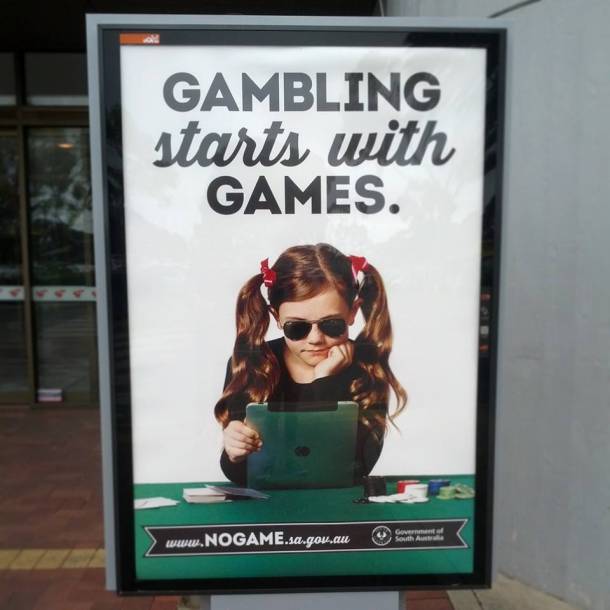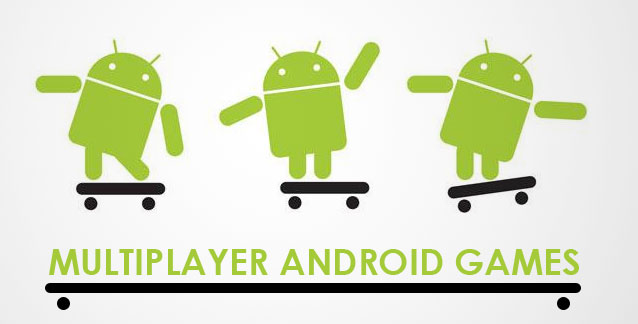


Take a look at this image borrowed from Kotaku Australia. It’s an advertising campaign recently launched by the Government of South Australia that was posted on bus stops and billboards in the region.
How does this image make you feel? Does this image make you mad? Or is it satisfying to finally see acknowledgment of a potential problem? Does it make a valid point? Or do you find it misleading?
Do you worry that the message that this image sends about video games to the uninformed masses is inaccurate or even a potential threat to the pastime? On the contrary, do you believe that it’s dutifully advising laypeople about the dangers of games as a gateway drug to problem gambling? Or do you simply feel that this advertisement is ultimately ineffective and of little importance or consequence, and that it can be safely ignored?
Would you want to prevent this advertisement from being seen by a mass audience?
If I know the audience that is likely to read this, here are my guesses as to how you responded: the advertisement makes you mad; you probably think it’s misleading at best and scaremongering at worst; you most likely worry that such an advertisement vilifies gaming unfairly, and that many non-gamers – particularly those who already harbor ill feelings towards the hobby – will lap the message up; and you’d probably prefer that something like this wasn’t out there in the wild, spreading unfair myths about video games to a mass audience that is probably quick to agree with it.
If I guessed your picks correctly, I want to make it quite clear that I agree with you 100%. But the point of this exercise is this: if you answered that string of questions in this way, you’ve (perhaps inadvertently) acknowledged the power of a simple image and four words. You’ve acknowledged that the subtle meanings encoded into this sign could be a persuasive means of perpetuating a myth, of misrepresenting your lifestyle, your hobby. You were perhaps defensive and wanted to stop that myth from spreading further and reaching impressionable eyes (which in this case it has, as successful lobbying by Australia’s Interactive Games and Entertainment Association (iGEA) has forced the Government of South Australia to remove the ads).
Why does the existence of this ad campaign upset or anger us? Why do we instinctively want to speak out against it? Many of us commonly downplay the power of advertising or media imagery to affect us, to influence us. That is, it seems, until we encounter media that we disagree with or that challenges our belief of ‘the way things are.’
Video games are “powerful,” “culturally relevant” and “an art form” when it suits us, but they’re “just games” and we’re “overthinking” them when it doesn’t. It’s one of the chief arguments leveled against egalitarian discourse around video-game culture: a belief that the audience that consumes video-game content is able to consciously parse and dismiss the stereotypes and the representations the medium perpetuates. Many in this space praise the storytelling nous, the emotional impact and the power to make a statement that this growing medium affords and, increasingly, delivers. Ironically, many will then rubbish the notion that the representations commonly featured within can have any kind of cultural impact.
As human beings, we are not blank slates, but neither are we born with our habits, attitudes, beliefs, values and expectations. We develop these from birth based upon what we perceive through our senses in the context of our environments. Subsequently, the environments in which we operate and the frequent messages we receive within them (no matter how subtle) play large roles in constructing our world view. It’s why a child born into, say, a Peruvian household is more likely to buy into Peruvian cultural values than into Latvian cultural values; a multitude of influences from that child’s immediate environment will shape his or her values, attitudes and beliefs; their subconscious “reality.” It’s also why, through the power of mass media, American cultural values have slowly infiltrated the ranks of many otherwise unrelated cultures.
Perhaps dangerously, we seem to downplay the role that the media we consume on a daily basis plays into how we view the world. It can be hard to admit; after all, no one likes to feel like or acknowledge that they’ve been influenced by external forces, particularly when it’s so subtle and on a subconscious level.
Sure, the media may not be stimuli that actually cause us to do anything. But I maintain that you’ll struggle to find a psychologist alive who disputes the notion that the media we consume contributes to our habits, attitudes, values and beliefs in some way.
Cultivation theory is one of the most popular approaches pertaining to media effects in the academic field of mass communication. Essentially, it posits (with compelling evidence, but also its share of criticism) that the more an individual consumes media, the more they’re likely to internalize the “social realities” said media portrays. Cultivation theory speaks to the power of any imagery that reaches a mass audience with frequency. While its original basis was largely in television and newspapers when it was first theorized in the ‘60s, it certainly applies to the full spectrum of media as we know it today. And where video games are concerned, who can deny the powerful cultural force they’ve become in recent times? To give but one recent example, Grand Theft Auto V is an indisputable cultural phenomenon that sold more than 11 million copies in its first 24 hours. As video-game enthusiasts, we tend to applaud such impressive sales numbers and revenue figures, but we shy away from the social responsibility that goes along with such an achievement. It’s just a game, after all; a game loaded with imagery and meaning that reaches millions.
The “parody” and “satire” defenses are often employed to justify unfavorable portrayals of race and gender in video games. The problem with this tactic is that both devices are essentially exaggerated takes on established and underlying cultural beliefs, and they rely on such for their effectiveness. While there is certainly effective parody and satire out there, it’s all based on the “it’s funny because it’s true” hook; it works because the audience believes there’s some truth to the joke at its core. When applied in a general sense to sectors of society as diverse as an entire race or an entire gender, it quickly becomes sweeping and problematic. And when it resonates with the audience, that encoded message reinforces that underlying belief. When you defend the use of these stereotypes, what are you really saying?
A blanket myth persists, for instance, that women are simply not as good at video games as men are, and it’s difficult to dispute that many are quick to agree with this. But where does such a myth come from? Do those who believe it think there’s something biological at work here? Even if you personally don’t believe this myth, it’s hard to deny that it’s a widespread one. That Gearbox’s John Hemingway used the term “Girlfriend Mode” as a synonym for “easy mode” when demoing Borderlands 2, and that we immediately understood it as such, points to this phenomenon. Threads like “Why are girls so bad at video games?” from the League of Legends forums – are commonplace in internet gaming communities. The discussion within is so matter-of-fact and self-assured, and almost all of it based on the assumption that girls are, in fact, just bad at games by nature. Such an underlying belief may seem “harmless” and “not a big deal” to many. But, through constant reinforcement, it can color both men’s interactions with women in the gaming community and also how women perceive themselves and their roles within that space. It’s not a stretch to suggest that men who harbor this belief are more likely to speak condescendingly to women when talking games and when interacting with them in online lobbies. Arguably, many women are likely to avoid the pastime altogether, either in reaction to such treatment or from cultivating this same belief themselves. And all because of what? A myth with no factual grounding whatsoever.
According to a Psychological Science meta-analysis of 217 studies as cited in this Time article, women would benefit from playing more action-style video games, developing valuable spatial skills in the process. But prevailing attitudes make indulging in certain video games an unappealing pastime for many women, presenting countless barriers and hurdles to a hobby that’s meant to be “fun.” As highlighted in a recent Polygon piece by Tracey Lien, the stereotype that video games are for boys is largely the result of a decades-old marketing strategy based on flawed and outdated data. And yet the stereotype prevails despite increasing and convincing evidence to the contrary; the 2013 Entertainment Software Association (ESA) sales, demographic and usage-data report shows that 45% of game players are female.
It’s precisely for these reasons that we cannot allow stereotypes, gender roles and other, similar manufactured myths to go unchallenged in our media. The more such messages are spread and perpetuated, the more likely we are to cultivate them on a subtle, subconscious level. Most of us aren’t even aware that it’s happening, and that’s the true danger. Just how many millions of people internalize and redistribute messages that aren’t grounded in reality – generalizations passed off as truth – that only serve to subordinate and exclude sectors of our society?
Imagine if the falsities of the “Gambling starts with games” ad from South Australia had that kind of reach.




 Dishonored Trailer Analysis: Heres What You Missed
Dishonored Trailer Analysis: Heres What You Missed Anno 2205 minimum and recommended hardware specs confirmed
Anno 2205 minimum and recommended hardware specs confirmed Borderlands The Pre-Sequel Review - Is it The Game For You?
Borderlands The Pre-Sequel Review - Is it The Game For You? Fallout 4: How to Get Armor for Dogmeat and Equip It
Fallout 4: How to Get Armor for Dogmeat and Equip It Trine 3: The Artifacts of Power Wiki – Everything you need to know about the game .
Trine 3: The Artifacts of Power Wiki – Everything you need to know about the game .